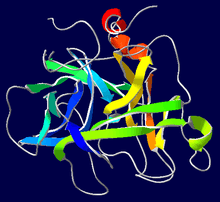Acrosin
Acrosin is a digestive enzyme that acts as a protease. In humans, acrosin is encoded by the ACR gene.[1][2] Acrosin is released from the acrosome of spermatozoa as a consequence of the acrosome reaction. It aids in the penetration of the Zona Pellucida.
Function
Acrosin is the major proteinase present in the acrosome of mature spermatozoa. It is a typical serine proteinase with trypsin-like specificity. It is stored in the acrosome in its precursor form, proacrosin. The active enzyme functions in the lysis of the zona pellucida, thus facilitating penetration of the sperm through the innermost glycoprotein layers of the ovum. The mRNA for proacrosin is synthesized only in the postmeiotic stages of spermatogenesis. In humans proacrosin first appears in the haploid spermatids.[3]
References
Further reading
- Elce JS, McIntyre EJ (1982). "Purification of bovine and human acrosin". Can. J. Biochem. 60 (1): 8–14. doi:10.1139/o82-002. PMID 6802470.
- Zheng X, Geiger M, Ecke S et al. (1994). "Inhibition of acrosin by protein C inhibitor and localization of protein C inhibitor to spermatozoa". Am. J. Physiol. 267 (2 Pt 1): C466–72. PMID 7521127.
- Kimura K, Wakamatsu A, Suzuki Y et al. (2006). "Diversification of transcriptional modulation: Large-scale identification and characterization of putative alternative promoters of human genes". Genome Res. 16 (1): 55–65. doi:10.1101/gr.4039406. PMC 1356129. PMID 16344560.
- Klemm U, Müller-Esterl W, Engel W (1991). "Acrosin, the peculiar sperm-specific serine protease". Hum. Genet. 87 (6): 635–41. doi:10.1007/bf00201716. PMID 1937464.
- Kim J, Bhinge AA, Morgan XC, Iyer VR (2005). "Mapping DNA-protein interactions in large genomes by sequence tag analysis of genomic enrichment". Nat. Methods 2 (1): 47–53. doi:10.1038/nmeth726. PMID 15782160.
- Moreno RD, Hoshi M, Barros C (1999). "Functional interactions between sulphated polysaccharides and proacrosin: implications in sperm binding and digestion of zona pellucida". Zygote 7 (2): 105–11. doi:10.1017/S0967199499000453. PMID 10418103.
- Liu RZ, Lu YL, Xu ZG et al. (2003). "[The effect of semen antisperm antibody on human sperm acrosin activity]". Zhonghua Nan Ke Xue 9 (4): 252–3. PMID 12931362.
- Steven FS, Griffin MM, Chantler EN (1982). "Inhibition of human and bovine sperm acrosin by divalent metal ions. Possible role of zinc as a regulator of acrosin activity". Int. J. Androl. 5 (4): 401–12. doi:10.1111/j.1365-2605.1982.tb00270.x. PMID 6815104.
- Marà SI, Rawe V, Biancotti JC et al. (2003). "Biochemical and molecular studies of the proacrosin/acrosin system in patients with unexplained infertility". Fertil. Steril. 79 Suppl 3: 1676–9. PMID 12801583.
- Glogowski J, Demianowicz W, Piros B, Ciereszko A (1998). "Determination of acrosin activity of boar spermatozoa by the clinical method: optimization of the assay and changes during short-term storage of semen". Theriogenology 50 (6): 861–72. doi:10.1016/S0093-691X(98)00191-5. PMID 10734459.
- Furlong LI, Veaute C, Vazquez-Levin MH (2005). "Binding of recombinant human proacrosin/acrosin to zona pellucida glycoproteins. II. Participation of mannose residues in the interaction". Fertil. Steril. 83 (6): 1791–6. doi:10.1016/j.fertnstert.2004.12.043. PMID 15950652.
- Furlong LI, Harris JD, Vazquez-Levin MH (2005). "Binding of recombinant human proacrosin/acrosin to zona pellucida (ZP) glycoproteins. I. Studies with recombinant human ZPA, ZPB, and ZPC". Fertil. Steril. 83 (6): 1780–90. doi:10.1016/j.fertnstert.2004.12.042. PMID 15950651.
- Hartley JL, Temple GF, Brasch MA (2000). "DNA Cloning Using In Vitro Site-Specific Recombination". Genome Res. 10 (11): 1788–95. doi:10.1101/gr.143000. PMC 310948. PMID 11076863.
- Collins JE, Wright CL, Edwards CA et al. (2004). "A genome annotation-driven approach to cloning the human ORFeome". Genome Biol. 5 (10): R84. doi:10.1186/gb-2004-5-10-r84. PMC 545604. PMID 15461802.
- Dubé C, Leclerc P, Baba T et al. (2005). "The proacrosin binding protein, sp32, is tyrosine phosphorylated during capacitation of pig sperm". J. Androl. 26 (4): 519–28. doi:10.2164/jandrol.04163. PMID 15955892.
- Strausberg RL, Feingold EA, Grouse LH et al. (2002). "Generation and initial analysis of more than 15,000 full-length human and mouse cDNA sequences". Proc. Natl. Acad. Sci. U.S.A. 99 (26): 16899–903. doi:10.1073/pnas.242603899. PMC 139241. PMID 12477932.
- Zahn A, Furlong LI, Biancotti JC et al. (2002). "Evaluation of the proacrosin/acrosin system and its mechanism of activation in human sperm extracts". J. Reprod. Immunol. 54 (1–2): 43–63. doi:10.1016/S0165-0378(01)00080-8. PMID 11839395.
- Howes E, Pascall JC, Engel W, Jones R (2001). "Interactions between mouse ZP2 glycoprotein and proacrosin; a mechanism for secondary binding of sperm to the zona pellucida during fertilization". J. Cell. Sci. 114 (Pt 22): 4127–36. PMID 11739644.
- Yudin AI, Vandevoort CA, Li MW, Overstreet JW (1999). "PH-20 but not acrosin is involved in sperm penetration of the macaque zona pellucida". Mol. Reprod. Dev. 53 (3): 350–62. doi:10.1002/(SICI)1098-2795(199907)53:3<350::AID-MRD11>3.0.CO;2-9. PMID 10369396.
External links
This article incorporates text from the United States National Library of Medicine, which is in the public domain.
